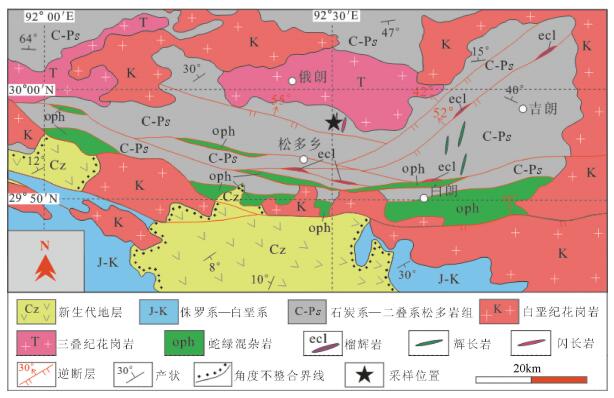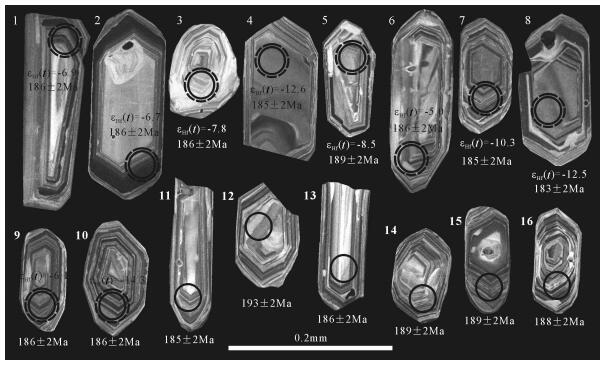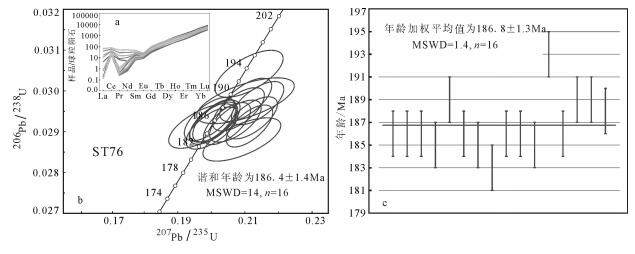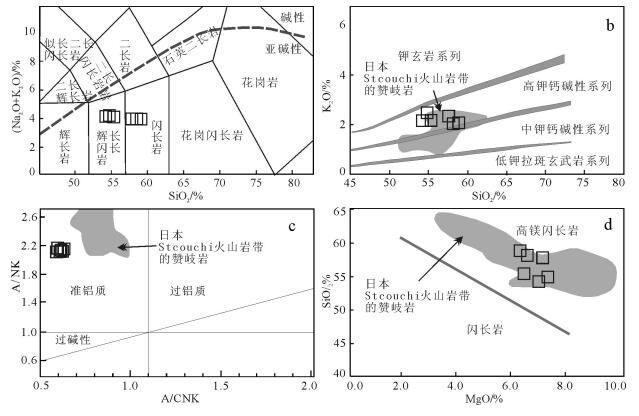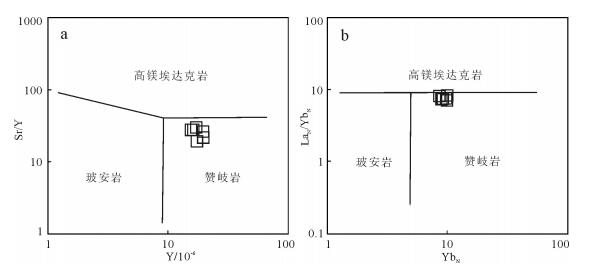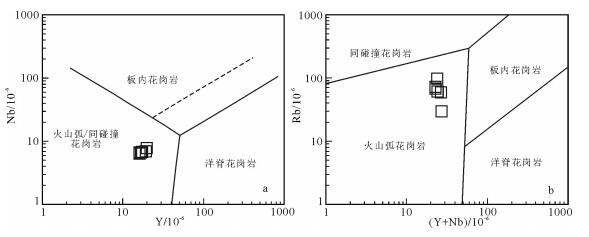The Early Jurassic subduction of Neo-Tethyan oceanic slab: Constraints from zircon U-Pb age and Hf isotopic compositions of Sumdo high-Mg diorite
-
摘要:
冈底斯岩浆岩带中东部松多地区新发现的高镁闪长岩对于探讨青藏高原新特提斯俯冲演化历史具有重要意义。通过松多高镁闪长岩的LA-ICP-MS锆石U-Pb年龄、锆石Hf同位素和全岩地球化学组成的研究,表明松多闪长岩的锆石U-Pb年龄加权平均值为186.8±1.3Ma。该类岩石具有高硅、高镁的特点,SiO2含量为54.17%~58.81%,MgO含量较高,介于6.26%~7.29%之间,Mg#值介于64~67之间,Cr和Ni含量高。该岩石富集轻稀土元素,具有平滑右倾的稀土元素配分曲线及弱负Eu异常。富集Rb、Ba、Pb、K等大离子亲石元素,亏损Nb、Ta、Ti等高场强元素。锆石负εHf(t)值(-5~-14.3)及远大于其侵入年龄的古老Hf模式年龄(1543~2129Ma),揭示松多早侏罗世闪长岩经历了古老地壳物质的部分熔融。Sr/Y-Y和(La/Yb)N-YbN判别图解显示,其形成可能与赞岐岩的岩浆作用过程相似,形成于消减带之上的地幔楔环境。综合研究表明,松多地区在早侏罗世处于雅鲁藏布新特提斯洋板片向欧亚大陆俯冲的活动陆缘构造背景。
-
关键词:
- 冈底斯 /
- 松多地区 /
- 早侏罗世 /
- LA-ICP-MS锆石U-Pb定年 /
- Hf同位素
Abstract:The high-Mg diorite newly discovered in Sumdo area in the eastern part of the Gangdise magmatic belt is of importance for investigating the evolution history of the subduction of Neo-Tethyan oceanic slab of Tibet. This paper reports LA-ICP-MS zircon U-Pb ages, zircon Hf isotopic and whole-rock major and trace element compositions of the high-Mg diorite. LA-ICP-MS zircon U-Pb isotopic dating indicates that the diorite was emplaced at 186.8±1.3Ma. It is characterized by high content of SiO2 (54.17%~58.81%), MgO (6.26%~7.29%), Mg# (64~67), Cr (294×10-6~373×10-6) and Ni (42×10-6~50×10-6). It is also characterized by smooth gently right-inclined REE patterns with slight enrichment of LREE and a little negative Eu anomaly. The large ion lithophile elements (LILEs) such as Rb, Ba, Pb, K are enriched, and the high field strength elements (HFSEs) such as Nb, Ta, Ti are depleted. LuHf isotopic study demonstrates that its εHf(t) values vary between -5 and -14.3, and the ancient zircon Hf crustal modal ages vary greatly from 1543Ma to 2129Ma, which indicates that the formation of Sumdo diorites resulted from partial melting of ancient crustal rocks. The discrimination diagrams of Sr/Y-Y and (La/Yb)N-YbN show that the high-Mg diorites were likely formed in a mantle wedge setting similar to the magmatic process of sanukitie. The comprehensive studies show that the Sumdo area was located in an active continental margin setting and affected by the subduction of the Yarlung Zangbo Neo-Tethyan oceanic slab towards Eurasia plate before Early Jurassic.
-
Keywords:
- Tibetan Plateau /
- Sumdo /
- Early Jurassic /
- LA-ICP-MS zircon U-Pb dating /
- Hf isotope
-
致谢: 锆石LA-ICP-MS原位微区U-Pb同位素测定得到中国地质大学(北京)苏犁教授的帮助,在此致以诚挚谢意。
-
图 1 冈底斯东段构造简图及其早侏罗世岩浆岩分布[3]
Figure 1. Sketch map of eastern Gangdise belt, showing the distribution of Early Jurassic magmatic rocks
图 9 松多闪长岩高镁安山岩分类图解[39]
Figure 9. The discrimination diagrams for HMA of Sumdo diorite
表 1 松多闪长岩(ST76)LA-ICP-MS锆石U-Th-Pb分析结果
Table 1 LA-ICP-MS U-Th-Pb analyses of zircons from the diorite (ST76) in Sumdo area
点号 含量/10-6 Th/U 207Pb/206Pb 207Pb/235U 206Pb/238U 207Pb/206Pb 207Pb/235U 206Pb/238U Th U 比值 1σ 比值 1σ 比值 1σ 年龄/Ma 1σ 年龄/Ma 1σ 年龄/Ma 1σ 1 206 580 0.36 0.0498 0.0012 0.2006 0.0048 0.0292 0.0003 186 34 186 4 186 2 2 349 930 0.38 0.0498 0.0011 0.2010 0.0043 0.0293 0.0003 185 29 186 4 186 2 3 238 650 0.37 0.0498 0.0012 0.2011 0.0049 0.0293 0.0003 187 36 186 4 186 2 4 193 303 0.64 0.0491 0.0017 0.1974 0.0067 0.0291 0.0004 154 56 183 6 185 2 5 220 495 0.44 0.0522 0.0013 0.2138 0.0051 0.0297 0.0004 294 34 197 4 189 2 6 303 776 0.39 0.0508 0.0012 0.2047 0.0046 0.0292 0.0003 233 31 189 4 186 2 7 216 580 0.37 0.0499 0.0013 0.2002 0.0051 0.0291 0.0003 191 38 185 4 185 2 8 320 657 0.49 0.0526 0.0020 0.2091 0.0077 0.0288 0.0004 313 90 193 6 183 2 9 218 547 0.40 0.0493 0.0012 0.1994 0.0049 0.0293 0.0004 163 35 185 4 186 2 10 352 700 0.50 0.0524 0.0012 0.2121 0.0050 0.0293 0.0003 304 33 195 4 186 2 11 619 916 0.68 0.0526 0.0011 0.2114 0.0046 0.0291 0.0003 312 28 195 4 185 2 12 192 339 0.57 0.0504 0.0016 0.2112 0.0067 0.0304 0.0004 212 50 195 6 193 2 13 285 659 0.43 0.0514 0.0013 0.2072 0.0051 0.0293 0.0003 257 35 191 4 186 2 14 558 722 0.77 0.0512 0.0024 0.2102 0.0096 0.0298 0.0004 251 111 194 8 189 2 15 542 777 0.70 0.0512 0.0013 0.2102 0.0051 0.0298 0.0004 249 34 194 4 189 2 16 498 830 0.60 0.0511 0.0013 0.2081 0.0051 0.0296 0.0004 244 35 192 4 188 2 表 2 松多闪长岩(ST76)锆石LA-ICP-MS原位稀土元素分析结果
Table 2 The trace element compositions of the zircons in the diorite (ST76) in Sumdo area by LA-ICP-MS
10-6 点号 La Ce Pr Nd Sm Eu Gd Tb Dy Ho Er Tm Yb Lu ∑REE 01 1.06 13.52 0.65 2.43 2.93 0.82 14.58 5.99 84.12 35.28 176.75 50.02 653.12 173.49 1215 02 0.04 19.89 0.03 0.69 2.60 1.12 16.78 7.60 106.02 46.08 228.32 63.78 826.25 216.30 1215 03 0.03 15.42 0.03 0.49 1.58 0.86 10.71 4.76 68.08 31.25 162.83 47.74 640.72 181.13 1169 04 0.03 11.07 0.03 0.67 1.36 0.68 7.30 2.67 35.69 14.80 73.49 21.68 299.68 86.18 559 05 0.03 12.04 0.02 0.29 0.98 0.51 6.28 2.42 34.33 15.12 77.90 23.49 325.66 93.27 597 06 9.93 37.44 2.87 14.47 5.09 1.32 17.55 7.02 95.91 40.46 202.72 56.38 731.30 195.07 1424 07 0.05 13.19 0.03 0.39 1.45 0.71 8.26 3.58 50.99 22.82 121.19 36.10 502.57 145.96 914 08 0.04 19.79 0.05 0.69 2.05 1.10 12.39 5.08 71.78 31.91 167.15 50.52 675.85 188.40 1235 09 0.04 15.96 0.03 0.54 1.42 0.79 9.14 3.76 54.75 24.74 130.63 38.96 543.96 162.47 996 10 0.05 18.40 0.04 1.41 3.51 1.23 19.64 7.75 104.23 42.02 203.29 55.23 692.35 178.56 1338 11 2.73 25.86 0.81 4.94 3.28 1.19 14.93 5.51 73.71 29.84 146.62 40.51 524.2 140.75 1026 12 0.16 9.13 0.08 1.81 4.33 1.22 20.39 7.44 91.56 34.18 156.2 40.25 478.05 120.97 978 13 16.65 50.20 4.87 25.11 7.22 1.59 16.45 5.73 75.11 30.49 150.33 42.01 550.88 145.16 1135 14 0.20 21.11 0.12 2.40 4.81 1.57 22.51 8.24 104.69 41.36 196.11 52.39 661.73 163.38 1295 15 0.03 14.71 0.04 0.73 2.18 0.89 12.93 4.98 66.21 26.29 122.53 32.55 413.27 106.38 819 16 4.21 27.21 1.47 7.51 3.62 1.03 10.93 3.97 50.45 21.12 108.11 30.39 402.18 115.79 804 表 3 松多闪长岩(ST76)LA-ICP-MS锆石Lu-Hf同位素组成
Table 3 The Lu-Hf isotope compositions of the zircons in the diorite (ST76) in Sumdo area as measured by LA-ICP-MS
点号 年龄/Ma 176Yb/177Hf 2σ 176Lu/177Hf 2σ 176Hf/177Hf 2σ εHf(0) εHf(t) TDM1 TDM2 fLu/Hf 01 186 0.034757 0.000514 0.001385 0.000030 0.282468 0.000028 -10.8 -6.9 1121 1662 -0.96 02 186 0.020124 0.000198 0.000731 0.000008 0.282470 0.000018 -10.7 -6.7 1099 1652 -0.98 03 186 0.069570 0.000895 0.002615 0.000053 0.282446 0.000026 -11.5 -7.8 1191 1719 -0.92 04 185 0.039694 0.000791 0.001311 0.000024 0.282307 0.000021 -16.5 -12.6 1347 2021 -0.96 05 189 0.040310 0.000422 0.001442 0.000009 0.282420 0.000021 -12.5 -8.5 1191 1768 -0.96 06 186 0.021209 0.000292 0.000783 0.000011 0.282519 0.000018 -9.0 -5.0 1032 1543 -0.98 07 185 0.042573 0.001080 0.001651 0.000054 0.282373 0.000023 -14.1 -10.3 1265 1877 -0.95 08 183 0.026939 0.000259 0.000966 0.000007 0.282308 0.000018 -16.4 -12.5 1333 2018 -0.97 09 186 0.025039 0.000459 0.000925 0.000016 0.282489 0.000020 -10.0 -6.1 1078 1611 -0.97 10 186 0.026789 0.000106 0.000917 0.000007 0.282257 0.000019 -18.2 -14.3 1402 2129 -0.97 表 4 松多闪长岩全岩主量、微量和稀土元素测定结果
Table 4 Major, trace element and REE compositions of the diorite in Sumdo area
样号 ST76-1 ST76-2 ST76-3 ST76-4 ST76-5 ST76-6 样号 ST76-1 ST76-2 ST76-3 ST76-4 ST76-5 ST76-6 SiO2 58.81 58.10 57.71 54.85 54.17 55.32 Li 87.20 72.26 60.30 31.12 31.46 24.72 TiO2 0.62 0.65 0.69 0.71 0.67 0.65 P 870.4 794.6 799.4 626.55 565.80 635.40 Al2O3 11.20 11.05 11.26 11.90 12.09 11.72 K 29360 24620 28740 16187 15728 17942 TFe2O3 7.48 7.82 8.18 8.70 8.58 8.41 Sc 51.98 47.56 51.84 36.98 37.56 39.84 MnO 0.12 0.13 0.13 0.14 0.14 0.13 Ti 5220 4766 5140 4038 4090 4286 MgO 6.26 6.54 7.10 7.29 6.97 6.41 V 275.8 249.2 272.6 238.7 244.1 254.0 CaO 6.98 7.36 6.93 7.45 8.04 7.43 Cr 326.8 294.2 339.8 318.8 329.0 373.4 Na2O 1.84 1.84 1.62 1.71 1.97 1.91 Mn 1060.8 981.4 1036.8 1157.4 1185.0 1214.0 K2O 2.06 2.05 2.34 2.49 2.18 2.19 Co 37.80 36.44 39.76 37.60 38.66 42.26 P2O5 0.13 0.13 0.13 0.12 0.11 0.12 Ni 43.78 42.66 45.82 42.74 43.60 51.32 烧失量 4.07 3.91 3.48 4.02 4.46 5.10 Cu 62.48 46.38 34.44 56.76 45.56 34.78 总量 99.57 99.58 99.57 99.38 99.38 99.39 Zn 57.86 59.12 54.62 66.37 70.42 61.22 Na2O+K2 3.90 3.89 3.96 4.20 4.14 4.10 Ga 17.38 15.47 15.53 14.07 14.00 13.83 A/CNK 0.62 0.59 0.63 0.63 0.60 0.62 Rb 29.74 63.58 59.12 76.92 74.72 97.10 A/NK 2.13 2.11 2.16 2.16 2.16 2.13 Sr 441.6 510.0 510.8 440.0 440.0 338.4 La 19.91 17.09 17.85 17.47 16.92 16.85 Y 19.86 17.26 19.53 16.20 15.96 17.54 Ce 43.14 37.72 39.32 37.78 36.74 36.96 Zr 121.46 108.64 107.82 103.66 103.88 99.44 Pr 5.17 4.52 4.77 4.62 4.47 4.62 Nb 7.49 6.73 6.82 6.47 6.39 6.33 Nd 19.94 17.40 18.88 17.28 16.71 17.64 Cs 2.94 2.41 3.29 2.52 2.33 3.06 Sm 4.20 3.67 4.05 3.62 3.49 3.76 Ba 448.0 435.8 374.6 425.2 454.8 383.4 Eu 1.06 0.93 0.99 0.92 0.90 0.95 Hf 2.86 2.61 2.64 2.62 2.60 2.34 Gd 3.73 3.28 3.64 3.40 3.33 3.63 Ta 0.45 0.41 0.42 0.43 0.42 0.41 Tb 0.54 0.48 0.54 0.49 0.48 0.52 Pb 7.79 8.56 7.12 9.07 10.71 8.80 Dy 3.24 2.86 3.21 3.01 2.96 3.22 Th 6.85 6.32 5.79 7.41 7.56 6.80 Ho 0.63 0.57 0.63 0.62 0.61 0.65 U 1.27 1.17 1.12 1.58 1.59 1.50 Er 1.83 1.63 1.83 1.73 1.70 1.84 Ta/Yb 0.27 0.28 0.26 0.27 0.27 0.24 Tm 0.26 0.23 0.25 0.26 0.25 0.27 Th/Yb 4.07 4.24 3.57 4.59 4.74 4.02 Yb 1.68 1.49 1.62 1.62 1.60 1.69 Nb+Y 27.35 23.99 26.35 22.66 22.35 23.87 Lu 0.24 0.21 0.24 0.25 0.25 0.26 注:主量元素含量单位为%,微量和稀土元素为10-6 表 5 冈底斯南缘早侏罗世岩浆岩年龄信息统计
Table 5 Age information of Early Jurassic magmatic rocks in southern margin of Gangdese
序号 样品编号 样品岩性 测试方法 年龄结果 采样位置 数据来源 1 S16T76 闪长岩 LA-ICP-MS锆石U-Pb 186.4±1.3Ma 松多乡北 本文 2 X-20 辉长岩 LA-ICP-MS锆石U-Pb 185.9±0.3Ma 墨脱南背崩 [2] 3 TB-1-6 英云闪长岩 LA-ICP-MS锆石U-Pb 179.7±1.7Ma 东嘎乡 [13] 4 TB-1-4 闪长岩(包体) LA-ICP-MS锆石U-Pb 177.4±1.7Ma 东嘎乡 [13] 5 13GB-10 安山岩 LA-ICP-MS锆石U-Pb 188.8±1.8Ma 得明顶 [50] 6 X03 流纹岩 LA-ICP-MS锆石U-Pb 174.4±1.7Ma 甲马沟叶巴组 [18] 7 Dy1425-2 黑云二长花岗岩 锆石U-Pb 187±10Ma 嘉黎县布久岩体 [19] 8 B553-1 花岗闪长岩 40Ar/30Ar 198.2±0.3Ma 金达地区 [20] 9 DZ05-1 英安岩 SHRIMP锆石U-Pb 174.2±3.6Ma 达孜 [10] 10 T384 变形花岗岩 LA-ICP-MS锆石U-Pb 178±1Ma 尼木大桥 [9] 11 b9041 白云母二长花岗岩 SHRIMP锆石U-Pb 190±8Ma 宁中 [16] 12 b7 白云母二长花岗岩 SHRIMP锆石U-Pb 193±7Ma 宁中 [16] 13 b50-2 白云母二长花岗岩 SHRIMP锆石U-Pb 191±10Ma 宁中 [16] 14 ST134A 花岗岩 SHRIMP锆石U-Pb 188.1±1.4Ma 南木林东 [7] 15 DZ-7 英安岩 锆石U-Pb 181±5Ma 达孜 [46] -
潘桂棠, 莫宣学, 侯增谦, 等.冈底斯造山带的时空结构及演化[J].岩石学报, 2006, 22(3):521-533. http://d.old.wanfangdata.com.cn/Periodical/ysxb98200603001 董汉文, 许志琴, 李源, 等.冈底斯东段墨脱地区早侏罗世辉长岩的成因及其构造意义[J].岩石学报, 2016, 33(12):3624-3634. http://www.wanfangdata.com.cn/details/detail.do?_type=perio&id=QKC20162017042100246217 朱弟成, 潘桂棠, 王立全, 等.西藏冈底斯侏罗纪岩浆作用的时空分布及构造环境[J].地质通报, 2008, 27(4):458-468. doi: 10.3969/j.issn.1671-2552.2008.04.003 朱弟成, 赵志丹, 牛耀龄, 等.拉萨地体的起源和古生代构造演化[J].高校地质学报, 2012, 18(1):1-15. doi: 10.3969/j.issn.1006-7493.2012.01.001 纪伟强, 吴福元, 锺孙霖, 等.西藏南部冈底斯岩基花岗岩时代与岩石成因[J].中国科学(D辑), 2009, 39(7):849-871. http://www.cnki.com.cn/Article/CJFDTOTAL-JDXK200907002.htm Ji W Q, Wu F Y, Chung S L, et al.Zircon U-Pb geochronology and Hf isotopic constraints on petrogenesis of the Gangdese batholith, southern Tibet[J].Chemical Geology, 2009, 262(3/4):229-245. doi: 10.1016-j.chemgeo.2009.01.020/
Chu M F, Chung S L, Song B, et al.Zircon U-Pb and Hf isotope constraints on the Mesozoic tectonics and crustal evolution of southern Tibet[J].Geology, 2006, 34(9):745-748. doi: 10.1130/G22725.1
和钟铧, 杨德明, 郑常青, 等.冈底斯带门巴花岗岩同位素测年及其对新特提斯洋俯冲时代的约束[J].地质论评, 2006, 52(1):100-106. doi: 10.3321/j.issn:0371-5736.2006.01.013 张宏飞, 徐旺春, 郭建秋, 等.冈底斯南缘变形花岗岩锆石U-Pb年龄和Hf同位素组成:新特提斯洋早侏罗世俯冲作用的证据[J].岩石学报, 2007, 23(6):1347-1353. doi: 10.3969/j.issn.1000-0569.2007.06.011 Zhu D C, Pan G T, Chung S L, et al.SHRIMP Zircon Age and Geochemical Constraints on the Origin of Lower Jurassic Volcanic Rocks from the Yeba Formation, Southern Gangdese, South Tibet[J]. International Geology Review, 2008, 50(5):442-471. doi: 10.2747/0020-6814.50.5.442
Guo L S, Liu Y L, Liu S W, et al.Petrogenesis of Early to Middle Jurassic granitoid rocks from the Gangdese belt, southern Tibet:Implications for early history of the Neo-Tethys[J]. Lithos, 2013, 179:320-333. doi: 10.1016/j.lithos.2013.06.011
Kang Z Q, Xu J F, Wilde S A, et al. Geochronology and geochemistry of the Sangri Group volcanic rocks, southern Lhasa terrane:Implications for the early subduction history of the Neo-Tethys and Gangdese magmatic arc[J].Lithos, 2014, 200/201:157-168. doi: 10.1016/j.lithos.2014.04.019
邱检生, 王睿强, 赵姣龙, 等.冈底斯中段早侏罗世辉长岩-花岗岩杂岩体成因及其对新特提斯构造演化的启示:以日喀则东嘎岩体为例[J].岩石学报, 2015, 31(12):3569-3580. http://d.old.wanfangdata.com.cn/Periodical/ysxb98201512005 黄丰, 许继峰, 陈建林, 等.早侏罗世叶巴组与桑日群火山岩:特提斯洋俯冲过程中的陆缘弧与洋内弧[J].岩石学报, 2015, 31(7):2089-2100. http://d.old.wanfangdata.com.cn/Periodical/ysxb98201507022 Dong H W, Xu Z Q, Li Y, et al.The Mesozoic metamorphicmagmatic events in the Medog area, the Eastern Himalayan Syntaxis:Constraints from zircon U-Pb geochronology, trace elements and Hf isotope compositions in granitoids[J].International Journal of Earth Sciences, 2015, 104(1):61-74. doi: 10.1007/s00531-014-1057-y
刘琦胜, 江万, 简平, 等.宁中白云母二长花岗岩SHRIMP锆石U-Pb年龄及岩石地球化学特征[J].岩石学报, 2006, 22(3):643-652. http://d.old.wanfangdata.com.cn/Periodical/ysxb98200603013 Geng Q R, Pan G T, Zheng L L, et al. The eastern Himalayan syntaxis:Major tectonic domains, ophiolitic mélanges and geologic evolution[J]. Journal of Asian Earth Sciences, 2006, 27(3):265-285. doi: 10.1016/j.jseaes.2005.03.009
董彦辉, 许继峰, 曾庆高, 等.存在比桑日群弧火山岩更早的新特提斯洋俯冲记录么?[J].岩石学报, 2006, 22(3):661-668. http://d.old.wanfangdata.com.cn/Periodical/ysxb98200603015 向树元, 泽仁扎西, 田立富, 等.中华人民共和国1:25万区域地质调查报告嘉黎县幅[M].北京:地质出版社, 2010. 杨德明, 和钟铧, 王天武, 等.中华人民共和国1:25万区域地质调查报告门巴区幅[M].北京:地质出版社, 2005. 杨经绥, 许志琴, 耿全如, 等.中国境内可能存在一条新的高压/超高压(?)变质带-青藏高原拉萨地体中发现榴辉岩带[J].地质学报, 2006, 80(12):1787-1792. doi: 10.3321/j.issn:0001-5717.2006.12.001 王斌, 解超明, 李才, 等.青藏高原松多地区温木朗蛇绿岩的发现及其地质意义[J].地质通报, 2017, 36(11):2076-2081. doi: 10.3969/j.issn.1671-2552.2017.11.017 陈松永, 杨经绥, 罗立强, 等.西藏拉萨地块MORB型榴辉岩的岩石地球化学特征[J].地质通报, 2007, 26(10):1327-1339. doi: 10.3969/j.issn.1671-2552.2007.10.011 徐向珍, 杨经绥, 李天福, 等.青藏高原拉萨地块松多榴辉岩的锆石SHRIMP U-Pb年龄及锆石中的包裹体[J].地质通报, 2007, 26(10):1340-1355. doi: 10.3969/j.issn.1671-2552.2007.10.012 Cheng H, Zhang C, Jeffrey D, et al. Zircon U-Pb and garnet Lu-Hf geochronology of eclogites from the Lhasa Block, Tibet[J]. Lithos, 2012, 155:341-359. doi: 10.1016/j.lithos.2012.09.011
Cheng H, Liu Y M, Jeffrey D, et al.Combined U-Pb, Lu-Hf, Sm-Nd and Ar-Ar multichronometric dating on the Bailang eclogite constrains the closure timing of the Paleo-Tethys Ocean in the Lhasa terrane, Tibet[J]. Gondwana Research, 2015, 28:1482-1499. doi: 10.1016/j.gr.2014.09.017
Yuan H L, Gao S, Liu X M, et al.Accurate U-Pb age and trace elment deteminations of zircon by laser ablation-inductively coupled plasma-mass spectrometry[J].Geostandards and Geoanlytical Research, 2004, 11:357-370. http://cn.bing.com/academic/profile?id=4a8e7a7fca3d10ce694c49bdb9efd4b5&encoded=0&v=paper_preview&mkt=zh-cn
Hu Z C, Liu Y S, Gao S, et al.Improved in situ Hf isotope ratio analysis of zircon using newly designed X skimmer cone and Jet sample cone in combination with the addition of nitrogen by laser ablation multiple collector ICP-MS[J]. Journal of Analytical Atomic Spectrometry, 2012, 27:1391-1399. doi: 10.1039/c2ja30078h
Liu Y S, Gao S, Hu Z C, et al.Continental and oceanic crust recycling-induced melt-peridotite interactions in the Trans-North China Orogen:U-Pb dating, Hf isotopes and trace elements in zircons of mantle xenoliths[J].Journal of Petrology, 2010, 51:537-571. doi: 10.1093/petrology/egp082
Hoskin P W O, Black L P.Metamorphic zircon formation by solid-state recrystallization of protolith igneous zircon[J].Journal of Metamorphic Geology, 2000, 18:423-439. http://www.wanfangdata.com.cn/details/detail.do?_type=perio&id=JJ026563309
吴福元, 李献华, 郑永飞, 等.Lu-Hf同位素体系及其岩石学应用[J].岩石学报, 2007, 23(2):185-220. http://d.old.wanfangdata.com.cn/Periodical/ysxb98200702001 Amelin Y, Lee D C, Halliday A N, et al. Nature of the Earth's earliest crust from hafnium isotopes in single detrital zircons[J].Nature, 1999, 399:252-255. doi: 10.1038/20426
Rickwood P C.Boundary lines within petrologic diagrams which use oxides of major and elements[J].Lithos, 1989, 22:247-263. doi: 10.1016/0024-4937(89)90028-5
Middlemost E A K.Iron oxidation ratios, norms and the classification of volcanic rocks[J].Chemical Geology, 1989, 77:19-26. doi: 10.1016/0009-2541(89)90011-9
Maniar P D, Piccoli P M.Tectonic discrimination of granitoids[J]. Geological Society of America Bulletin, 1989, 101(5):635-643. doi: 10.1130/0016-7606(1989)101<0635:TDOG>2.3.CO;2
Boynton W V.Cosmochemistry of the rare earth elements:Meteorites studies[J].Development in Geochemistry, 1984:63-114. http://cn.bing.com/academic/profile?id=a86bc72c95d06bcdf62c0e1eb55bf851&encoded=0&v=paper_preview&mkt=zh-cn
Sun S S, McDonough W F.Chemical and isotopic systematics of oceanic basalt:implications for mantle composition and processes[J].Geological Society, London, Specical Publications, 1989, 42:313-345. doi: 10.1144/GSL.SP.1989.042.01.19
付长亮, 孙德有, 张兴洲, 等.吉林珲春三叠纪高镁闪长岩的发现及地质意义[J].岩石学报, 2010, 26(4):1089-1102. http://d.old.wanfangdata.com.cn/Periodical/ysxb98201004007 Kamei A, Owada M, Nagao T, et al. High-Mg diorites derived from sanukitic HMA magmas, Kyushu Island, southwest Japan arc:Evidence from clinopyroxene and whole rock compositions[J]. Lithos, 2004, 75:359-371. doi: 10.1016/j.lithos.2004.03.006
Kelemen P B, Hanghoj K, Greene A R, et al. One View of the Geochemistry of Subduction-Related Magmatic Arcs, with an Emphasis on Primitive Andesite and Lower Crust[J].Treatise on Geochemistry, 2003, 3:593-659. https://www.researchgate.net/publication/234393905_One_View_of_the_Geochemistry_of_Subduction-Related_Magmatic_Arcs_with_an_Emphasis_on_Primitive_Andesite_and_Lower_Crust
张旗, 王焰, 钱青, 等.晚太古代Sanukite (赞岐岩)与地球早期演化[J].岩石学报, 2004, 20(6):1355-1362. http://d.old.wanfangdata.com.cn/Periodical/ysxb98200406005 张旗, 钱青, 翟明国, 等.Sanukite(赞岐岩)的地球化学特征、成因及其地球动力学意义[J].岩石矿物学杂志, 2005, 24(2):117-125. doi: 10.3969/j.issn.1000-6524.2005.02.005 李化启, 蔡智慧, 陈松永, 等.拉萨地体中的印支期造山事件及年代学证据[J].岩石学报, 2008, 24(7):1595-1604. http://www.wanfangdata.com.cn/details/detail.do?_type=perio&id=ysxb98200807015 李化启, 许志琴, 杨经绥, 等.拉萨地体内松多榴辉岩的同碰撞折返:来自构造变形和40Ar/39Ar年代学的证据[J].地学前缘, 2011, 18(3):66-78. http://d.old.wanfangdata.com.cn/Periodical/dxqy201103008 Zedde D, Wortel M. Shallow slab detachment as a transient source of heat at midlithospheric depths[J]. Tectonics, 2001, 20(6):868-882. doi: 10.1029/2001TC900018
更全如, 潘桂棠, 王立全, 等.西藏冈底斯带叶巴组火山岩同位素地质年代[J].沉积与特提斯地质, 2006, 26(1):1-7. doi: 10.3969/j.issn.1009-3850.2006.01.001 Zhu D C, Zhao Z D, Niu Y L, et al.The Lhasa Terrane:Record of a microcontinent and its histories of drift and growth[J].Earth and Planetary Science Letters, 2011, 301(1/2):241-255. doi: 10.1016-j.epsl.2010.11.005/
England P, Houseman G. Finite strain calculations of continental deformation 2. Comparison with the India-Asia collision zone[J]. Journal of Geophysical Research, 1986, 91(3):3664-3676. doi: 10.1029-JB091iB03p03664/
Murphy M A, Yin A, Harrison T M, et al. Did the Indo-Asian collision alone create the Tibetan Plateau?[J]. Geology, 1997, 25(8):719-722. doi: 10.1130/0091-7613(1997)025<0719:DTIACA>2.3.CO;2
熊秋伟, 陈建林, 许继峰, 等.拉萨地块南部得明顶地区叶巴组火山岩LA-ICP-MS锆石U-Pb年龄、地球化学特征及其成因[J].地质通报, 2015, 34(9):1645-1655. doi: 10.3969/j.issn.1671-2552.2015.09.006 王玉净, 松冈笃.藏南泽当雅鲁藏布缝合带中的三叠纪放射虫[J].微体古生物学报, 2002, 19(3):215-227. doi: 10.3969/j.issn.1000-0674.2002.03.001



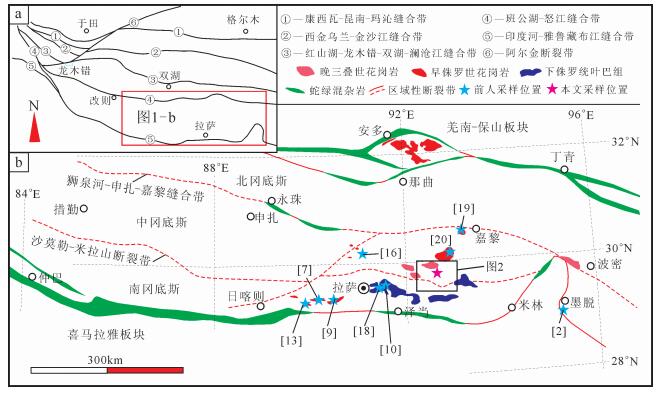
 下载:
下载:
